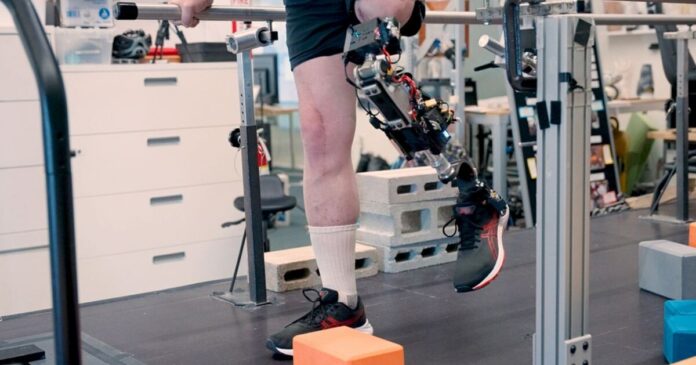Researchers at the Massachusetts Institute of Technology (MIT) have developed a method to restore astoundingly natural movement in people who have had leg amputations above the knee. Rather than fit an artificial limb into a socket, the team has created a bionic knee that can be integrated with a patient’s muscle and bone – enabling them to move much more easily than with previous prostheses.
The new bone-integrated system, dubbed e-OPRA (enhanced Osseointegrated Prostheses for the Rehabilitation of Amputees), is said to not only help patients walk faster, climb stairs, and avoid obstacles with ease, but also provide greater stability and control over movements.
In the video below, you can see a patient – with just a few inches of upper thigh and femur connected to the new prosthetic limb – demonstrating motion that’s surprisingly fluid as they walk and kick a ball.
Introducing: The Osseointegrated Mechanoneural Prosthesis
The tech comes from a team including Media Arts & Sciences professor Hugh Herr, who’s been running a biomechatronics lab at MIT for years. Herr developed a deep passion for mountain climbing in his early teens, lost the lower halves of both legs to frostbite after being caught in a blizzard, resumed climbing, and subsequently led pioneering research in prosthetics. A brief profile of Herr is provided in the clip below.
Superhuman Body – Dr. Hugh Herr, Innovator of Bionic Limbs
This breakthrough follows work presented by Herr and his team from last year, where they showed how nervous-system-driven prostheses for below-the-knee amputees gave them greater control over their movements. Indeed, both projects follow a surgical technique that Herr’s lab has been exploring for years called agonist-antagonist myoneuronal interface (AMI), which involves reconnecting muscle pairs so they can communicate their position and the speed of their contraction with each other within the residual limb.
That sensory feedback helps the patient decide how to move their prosthetic limb, and accurately control it. The above-the-knee system features a titanium rod implanted into the residual femur bone, along with wires that gather information from electrodes located on the AMI muscles within the body. The idea behind this approach is to provide better load-bearing and mechanical control of the prosthesis than a socket-based option, while avoiding the possibility of skin infections.
Image courtesy of the researchers
Signals from the AMI muscles are transmitted to a custom-built robotic controller, which calculates the torque necessary to move the bionic knee just the way the user intends.
Two study participants who had received the combined AMI and e-OPRA system performed better at numerous physical tasks involving the prosthetics than others who had the AMI surgery but not the e-OPRA implant, and a third group who had neither AMI nor e-OPRA.
Additionally, the researchers found that the two participants who received the combined bionic knee system showed significantly greater feelings of agency and ownership of the prosthesis as part of their body. The study’s findings were published in the journal Science last week.
“No matter how sophisticated you make the AI systems of a robotic prosthesis, it’s still going to feel like a tool to the user, like an external device,” says Herr. “But with this tissue-integrated approach, when you ask the human user what is their body, the more it’s integrated, the more they’re going to say the prosthesis is actually part of self.”
Hopefully, this work will make advanced prosthetics for above-the-knee amputees more easily accessible in the near future. Herr expects that could take about five years, during which time the combined AMI and e-OPRA systems will go through larger clinical trials for Food and Drug Administration (FDA) approval in the US.
The team’s work follows some fascinating recent innovations in more natural artificial limbs. Last year, researchers in Italy created an intricate unpowered prosthetic foot with a structure designed to closely replicate the bones in a real foot. And earlier this year, biomedical engineers at Johns Hopkins University presented a prosthetic hand that can grip a range of objects with just the right amount of pressure needed to hold them securely without damaging them.
Source: MIT News


